[FREE] Fun Math Games & Activities Packs
Always on the lookout for fun math games and activities in the classroom? Try our ready-to-go printable packs for students to complete independently or with a partner!
In order to access this I need to be confident with:
Commutative propertyUnderstanding multiplication
Whole numbers Prime numbersFactors
Here you’ll learn about factors, including recognizing factors, the commutative property, how to find all factor pairs of a given number, and solving problems using factors.
Students will first learn about factors as part of operations and algebraic thinking in elementary school.
What are factors?
Factors are numbers that multiplied together to find a product. They are whole numbers and can sometimes be called divisors.
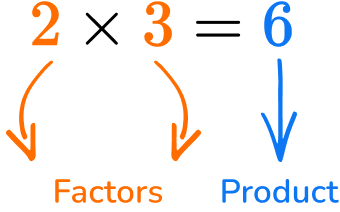
Every whole number greater than \bf{1} has at least \bf{2} factors.
If a whole number has more than two factors it is called a composite number.
If a number has only two factors, it is a prime number.
Step-by-step guide: Prime & composite numbers
- A factor pair is two numbers that are multiplied to create a product.
For example, here are the factor pairs of 12.
| Factor Pair | Array (row × columns) | Product |
|---|---|---|
| 1\times{12} | 12 | |
| 2\times{6} | 12 | |
| 3\times{4} |  | 12 |
Factor pairs have a commutative property which means you can switch the order and the product is the same.
For example,
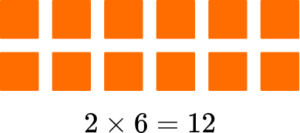

- Prime factors are factors of a number that are also prime numbers
For example, the prime factors of 30=2\times{3}\times{5}.
Step-by-step guide: Prime factors
Factors are very useful. You can use them to find common denominators, calculating areas and simplify algebraic expressions in upper grades!
What are factors?
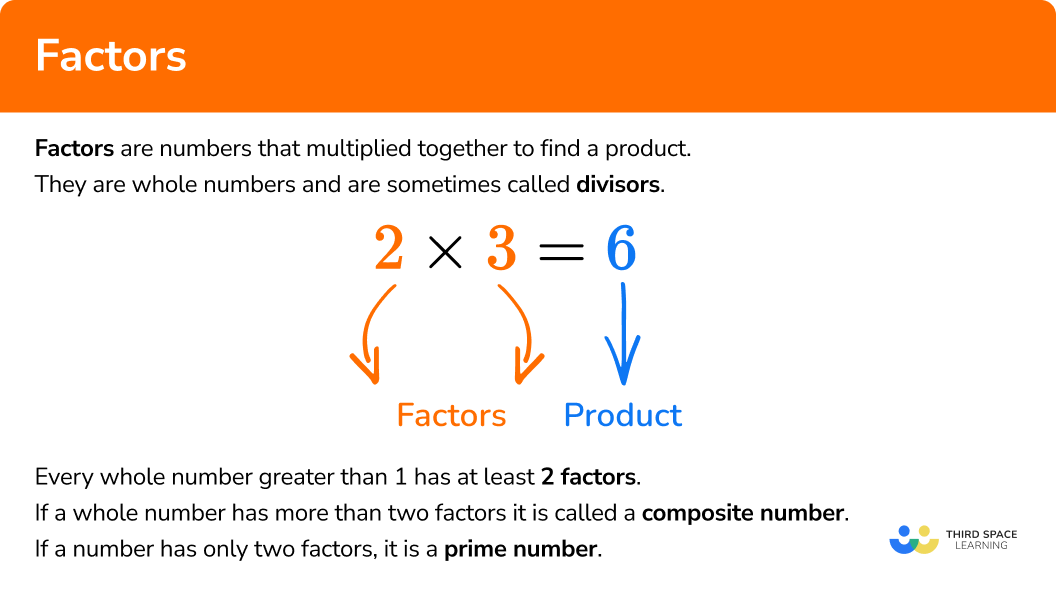
Common Core State Standards
How does this relate to 3rd grade math and 4th grade math?
- Grade 3: Operations & Algebraic Thinking (3.OA.B.5)
Apply properties of operations as strategies to multiply and divide.
- Grade 4: Operations & Algebraic Thinking (4.OA.B.4)
Find all factor pairs for a whole number in the range 1–100. Recognize that a whole number is a multiple of each of its factors. Determine whether a given whole number in the range 1–100 is a multiple of a given one-digit number. Determine whether a given whole number in the range 1–100 is prime or composite.
How to list factors
In order to list all of the factor pairs of a given number:
- State the pair \bf{1} \, \textbf{×} \, the number.
- Write the next smallest factor of the number and calculate its factor pair.
- Repeat until the next factor pair is the same as the previous pair.
- Write out the list of factors for a number.
![[FREE] Factors Worksheet (Grades 4 & 5)](https://thirdspacelearning.com/wp-content/uploads/2023/02/Factors-worksheet-resource-lander-image.png)
[FREE] Factors Worksheet (Grades 4 & 5)
![[FREE] Factors Worksheet (Grades 4 & 5)](https://thirdspacelearning.com/wp-content/uploads/2023/02/Factors-worksheet-resource-lander-image.png)
Use this worksheet to check your grade 4 and 5 students’ understanding of factors. 15 questions with answers to identify areas of strength and support!
DOWNLOAD FREE![[FREE] Factors Worksheet (Grades 4 & 5)](https://thirdspacelearning.com/wp-content/uploads/2023/02/Factors-worksheet-resource-lander-image.png)
[FREE] Factors Worksheet (Grades 4 & 5)
![[FREE] Factors Worksheet (Grades 4 & 5)](https://thirdspacelearning.com/wp-content/uploads/2023/02/Factors-worksheet-resource-lander-image.png)
Use this worksheet to check your grade 4 and 5 students’ understanding of factors. 15 questions with answers to identify areas of strength and support!
DOWNLOAD FREEFactors examples
Example 1: listing factors (even number)
List the factors of 24.
- State the pair \bf{1} \, \textbf{×} \, the number.
The factor pair is 1\times{24}.
2Write the next smallest factor of the number and calculate its factor pair.
As 24 is an even number, 2 is a factor of 24.
24\div{2}=12so the next factor pair is
2\times{12}.3Repeat until the next factor pair is the same as the previous pair.
So far there is:
\begin{aligned} 1\times{24}\\ 2\times{12} \end{aligned} 24\div{3}=8and so the next factor pair is
3\times{8} 24\div{4}=6and so the next factor pair is
4\times{6} 24\div{5}=4.8which is a decimal so 5 is not a factor of 24
The next factor to try is 6. As factors are commutative,
6\times{4}=4\times{6}which is the same as the previous factor pair.
Now all of the factor pairs have been found:
\begin{aligned} &1\times{24}\\ &2\times{12}\\ &3\times{8}\\ &4\times{6} \end{aligned}4Write out the list of factors for the given number.
Reading down the first column of factors, and up the second column, the factors of 24 are: 1, 2, 3, 4, 6, 8, 12, 24.
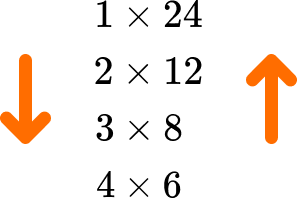
Example 2: listing factors (odd number)
List the factors of 27.
State the pair \bf{1} \, \textbf{×} \, the number.
The number = \, 27 we have the first factor pair
1\times{27}.
Write the next smallest factor of the number and calculate its factor pair.
As 27 is an odd number, 2 is not a factor of 27.
However, 27\div{3}=9
and so the next factor pair is
3\times{9}.
Repeat until the next factor pair is the same as the previous pair.
So far we have:
\begin{aligned} &1\times{27}\\ &3\times{9} \end{aligned}
27 has a remainder when it is divided by 4, 5, 6, 7, or 8.
The next factor to try is 9, but we already know that 3\times{9} is a factor pair and this is the same as 9\times{3}.
We have now found all of the factor pairs:
\begin{aligned} &1\times{27}\\ &3\times{9} \end{aligned}
Write out the list of factors for the given number.
Reading down the first column of factors, and up the second column, the factors of 27 are: 1, 3, 9, and 27.

Example 3: listing factors when there is a repeated factor
List the factors of 36.
State the pair \bf{1} \, \textbf{×} \, the number.
The number = \, 36 we have the first factor pair
1\times{36}.
Write the next smallest factor of the number and calculate its factor pair.
As 36 is an even number, 2 is a factor of 36.
36\div{2}=18
and so the next factor pair is
2\times{18}.
Repeat until the next factor pair is the same as the previous pair.
So far we have:
\begin{aligned} &1\times{36}\\ &2\times{18} \end{aligned}
36\div{3}=12
and so the next factor pair is
3\times{12}
36\div{4}=9
and so the next factor pair is
4\times{9}
36 has a remainder when it is divided by 5 and so 5 is not a factor.
36\div{6}=6
and so the next factor pair is
6\times{6}
We have reached a repeated factor and so we have found all of the factor pairs for 36:
\begin{aligned} &1\times{36}\\ &2\times{18}\\ &3\times{12}\\ &4\times{9}\\ &6\times{6} \end{aligned}
Write out the list of factors for the given number.
Reading down the first column of factors, and up the second column, the factors of 36 are: 1, 2, 3, 4, 6, 9, 12, 18, and 36.
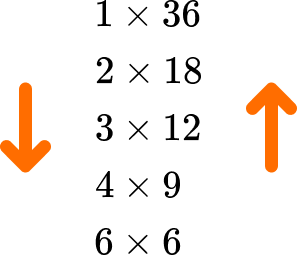
Example 4: listing factors (prime number)
List the factors of 7.
State the pair \bf{1} \, \textbf{×} \, the number.
The number = \, 7 we have the first factor pair
1\times{7}.
Write the next smallest factor of the number and calculate its factor pair.
As 7 is an odd number, 2 is not a factor of 7.
7 has a remainder when it is divided by 2, 3, 4, 5, and 6.
Repeat until the next factor pair is the same as the previous pair.
The next whole number to try is 7, which we have already used
(1\times{7}=7\times{1})
and so the only factor pair for the number 7 is
1\times{7}.
Write out the list of factors for the given number.
The factors of 7 are: 1 and 7.

As 7 has only two factors, 1 and itself, 7 is a prime number.
Example 5: listing factors of any number (3 digit number)
List the factors of 200.
State the pair \bf{1} \, \textbf{×} \, the number.
The number = \, 200 we have the first factor pair
1\times{200}.
Write the next smallest factor of the number and calculate its factor pair.
As 200 is an even number, 2 is a factor of 200.
200\div{2}=100
and so the next factor pair is
2\times{100}.
Repeat until the next factor pair is the same as the previous pair.
So far we have:
\begin{aligned} &1\times{200}\\ &2\times{100} \end{aligned}
200 has a remainder when it is divided by 3 and so 3 is not a factor.
200\div{4}=50
and so the next factor pair is
4\times{50}.
200\div{5}=40
and so the next factor pair is
5\times{40}.
200 has a remainder when it is divided by 6 and 7 and so these are not factors of 200.
200\div{8}=25
and so the next factor pair is
8\times{25}.
200 has a remainder when it is divided by 9 and so 9 is not a factor.
200\div{10}=20
and so the next factor pair is
10\times{20}.
200 has a remainder when it is divided by 11, 12, 13, 14, 15, 16, 17, 18, and 19 and so these are not factors of 200.
The next integer to try is 20 but this appears in the previous factor pair
(10\times{20}=20\times{10}).
We have therefore found all of the factor pairs for 200:
\begin{aligned} 1&\times{200}\\ 2&\times{100}\\ 4&\times{50}\\ 5&\times{40}\\ 8&\times{25}\\ 10&\times{20} \end{aligned}
Write out the list of factors for the given number.
Reading down the first column of factors, and up the second column, the factors of 200 are: 1, 2, 4, 5, 8, 10, 20, 25, 40, 50, 100, and 200.
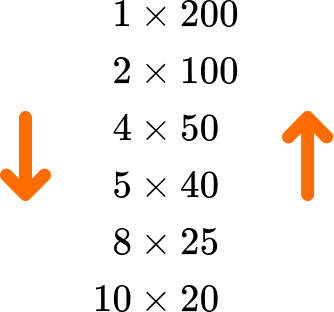
Example 6: using factors to solve word problems
A store needs 18 boxes of crackers. The boxes need to be stacked with the same number of boxes in each row. There needs to be more than 1 row of boxes and less than 18 rows. How many different ways can the rows be created?
State the pair \bf{1} \, \textbf{×} \, the number.
1 \times 18 is the first factor pair. However, this will not be used because there needs to be more than 1 row of boxes.
Write the next smallest factor of the number and calculate its factor pair.
18 is an even number, 2 is a factor of 9.
9\times{2}=18, which means there can be 9 rows of 2 boxes
2\times{9}=18, which means there can be 2 rows of 9 boxes.
9 rows of 2 boxes is different from 2 rows of 9 boxes.


Repeat until the next factor pair is the same as the previous pair.
18 does not have a remainder when it is divided by 3. \, 3 is a factor of 18.
3 \times 6=18, which means there can be 3 rows of 6 boxes.
6 \times 3=18, which means there can be 6 rows of 3 boxes.
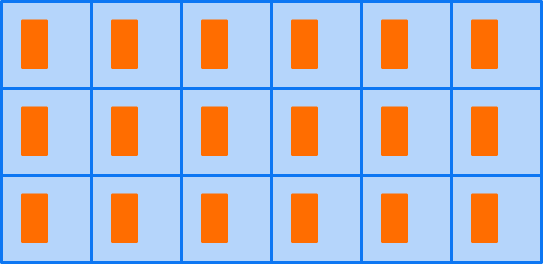
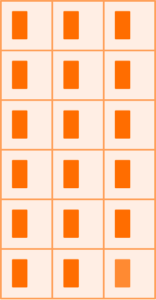
Write out the list of factors for the given number.
There are 4 different ways the rows can be created.
2 rows \times \; 9 columns
9 rows \times \; 2 columns
3 rows \times \; 6 columns
6 rows \times \; 3 columns
Teaching tips for finding factors
- Identifying factors is usually more difficult for students than finding multiples. Using manipulatives helps students to find positive factors, such as counters.
- Visual models such as arrays help students to organize the positive factors of the original number.
- Have students identify patterns when finding factors. Hundreds charts and multiplication tables are very helpful to students in identifying patterns of factors.
Our favorite mistakes
- Confusing factors and multiples
Factors are two or more whole numbers multiplied, like 5 \times 4. Multiples are the products of factors, like the multiples of 5 are 5, 10, 15, 20.
- Remember \bf{1} and the number itself are factors
All numbers are a factor of themselves and 1 is a factor of every number.
For example, the factors of 6 are: 1, 2, 3, 6 and so 6 is a factor of itself.
Related lessons on factors and multiples
Practice factors questions
1. List the factors 12.

1 and 12, 2 and 6



The factor pairs of 12 are:
\begin{aligned} 1&\times{12}\\ 2&\times{6}\\ 3&\times{4} \end{aligned}
So the factors of 12 are 1, 2, 3, 4, 6 and 12.
2. List the factors of 15.


3 and 5


The factor pairs of 15 are:
\begin{aligned} 1&\times{15}\\ 3&\times{5} \end{aligned}
So the factors of 15 are 1, 3, 5, and 15.
3. List the factors of 64.
1 and 64, 2 and 32




The factor pairs of 64 are:
\begin{aligned} 1&\times{64}\\ 2&\times{32}\\ 4&\times{16}\\ 8&\times{8} \end{aligned}
So the factors of 64 are 1, 2, 4, 8, 16, 32, and 64.
4. List the factors of 17.



1 and 17

The factor pairs of 17 are:
1\times{17}
So the factors of 17 are 1 and 17.
5. List the factors of 120.

12 and 10, 6 and 20, 4 and 30.



The factor pairs of 120 are:
\begin{aligned} 1&\times{120}\\ 2&\times{60}\\ 3&\times{40}\\ 4&\times{30}\\ 5&\times{24}\\ 6&\times{20}\\ 8&\times{15}\\ 10&\times{12} \end{aligned}
So the factors of 120 are 1, 2, 3, 4, 5, 6, 8, 10, 12, 15, 20, 24, 30, 40, 60 and 120.
6. A department store just received a shipment of 12 boxes of waffle makers. The store worker has to stack the boxes with the same number of boxes in each row. The manager wants more than 1 box in each row and less than 12 boxes in each row. How can the boxes be arranged?
3 rows \times \; 4 columns

12 rows \times \; 1 column

1 row \times \; 12 columns

24 rows \times \; 2 columns

The factor pairs of 12 are:
\begin{aligned} 1&\times{12}\\ 12&\times{1}\\ 2&\times{6}\\ 6&\times{2}\\ 3&\times{4}\\ 4&\times{3} \end{aligned}
Since there has to be more than 1 row and less than 12 rows, the only factor pair that would work is 3 rows \times \; 4 columns.
Factors FAQ
Knowing divisibility rules is very helpful when finding factors. However, using the steps to find factors is also a helpful tool.
No, factors and multiples are not the same. Factors are two or more whole numbers multiplied together that give a product. In other words, a factor divides a number and leaves no remainder. A multiple is the product when one number is multiplied by another number.
No, factors can be negative numbers. However, in elementary school students typically work only with positive numbers.
No, a quotient is the number resulting from division. A factor divides another number leaving no remainder.
No, factor pairs are any two whole numbers that multiply to the given number.
The next lessons are
Still stuck?
At Third Space Learning, we specialize in helping teachers and school leaders to provide personalized math support for more of their students through high-quality, online one-on-one math tutoring delivered by subject experts.
Each week, our tutors support thousands of students who are at risk of not meeting their grade-level expectations, and help accelerate their progress and boost their confidence.

Find out how we can help your students achieve success with our math tutoring programs.
[FREE] Common Core Practice Tests (Grades 3 to 6)
Prepare for math tests in your state with these Grade 3 to Grade 6 practice assessments for Common Core and state equivalents.
40 multiple choice questions and detailed answers to support test prep, created by US math experts covering a range of topics!

